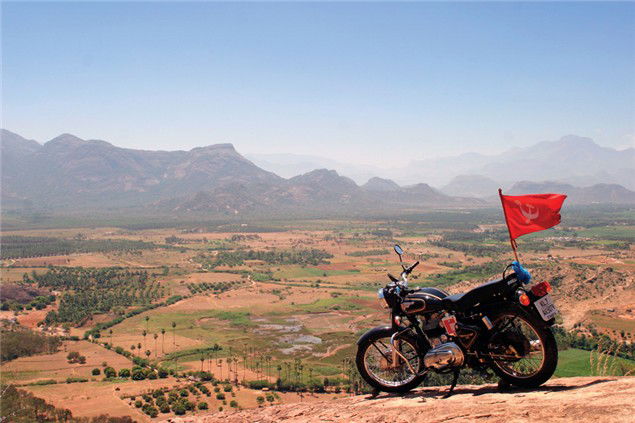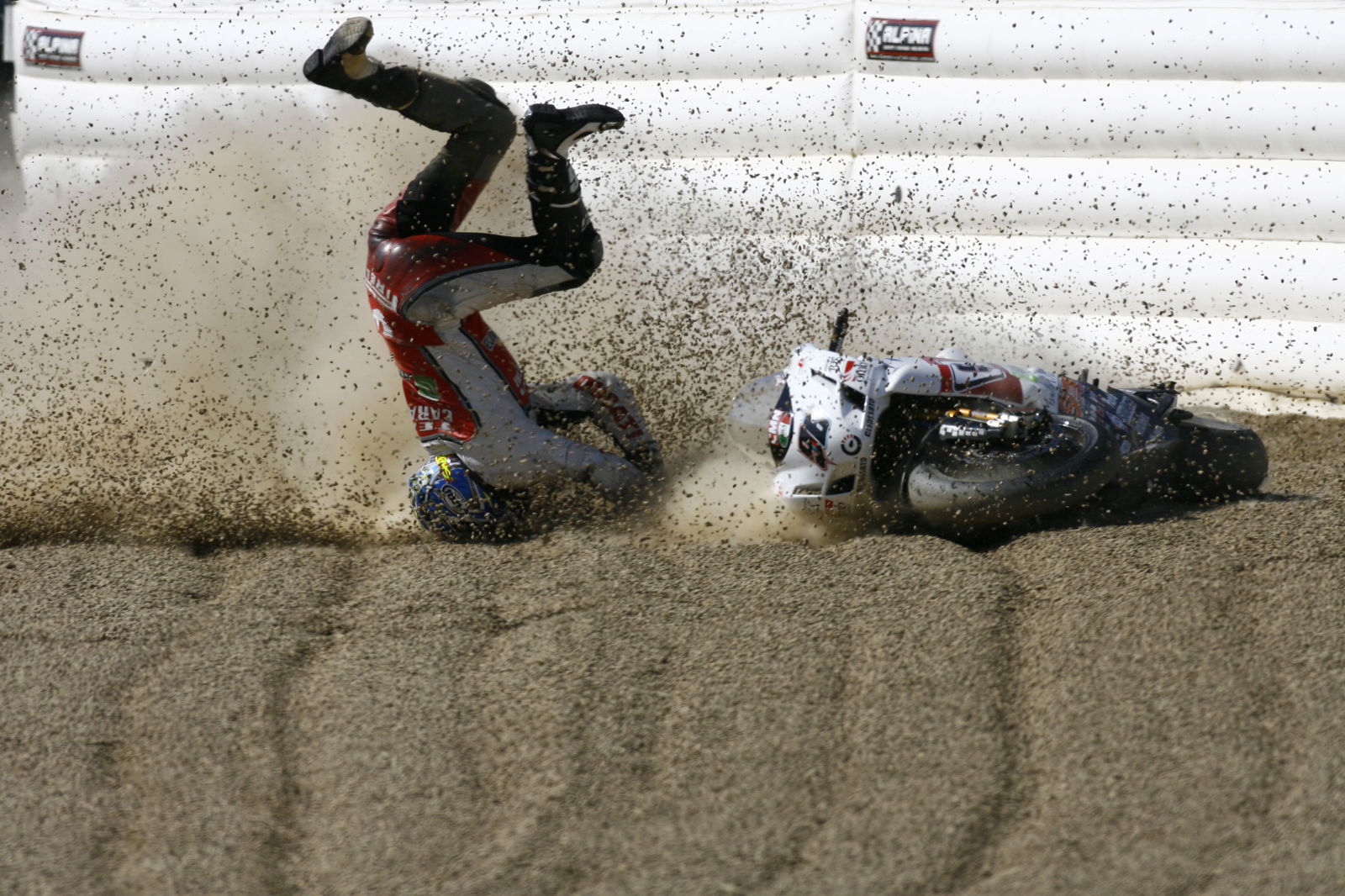Indian Takeaway - Enduro India
If you need a break from the drudgery of working life, if you want to ride a bike in a place where traffic laws are non-existent and you can do pretty much whatever you want, well, you need to go to India


Southern India is not the most obvious place in the world for a British motorcycle rally. For starters, it's 10 hours away by plane with an eight-hour stopover in Sri Lanka. Then, once you arrive, there's the combination of lethal traffic, appalling roads and quaint indigenous motorcycles that fall to pieces. You'll be lucky not to get the shits, if you don't like curry you'll go hungry and, despite being the world's largest producer of tea, it's virtually impossible to get a decent brew. I've never been before because it's dirty, smelly and overcrowded.
So, when we finally arrive in India and one zealous participant tries to rouse 100 jet-lagged souls with a stirring shout of "Enduro India 2005 is go!" I decide, there and then, that Enduro India is going to be a disaster.
As usual, I am staggeringly wrong. Enduro India is a thundering success and turns out to be one of the most illuminating, mind-broadening and riotously fun things I have done on a motorcycle in recent times. The format of the event is very simple: a 150- kilometre, seven-day lap around around Southern India on 350cc Royal Enfield bikes. In practice, however, this requires an organisational feat on a par with the 1969 moon landing and incredible commitment by both the team and paying punters alike. Just getting to Calicut - where the rally kicks off - is a huge feat, requiring us to cough up £500, raise another £3000 for charity and find two weeks off work. In India, where it takes two hours to do something as simple as changing a plane ticket, it is amazing the enduro happens at all.
Of course, it's not a real enduro. There are no prizes for first place, there are no check-points or special stages. But there are bloody tough roads to cover, and I challenge anyone to ride 250kms in the
sadistic saddle of an Enfield and not squirm in searing discomfort. It's a proper Iron Butt event, and for the last two years has been the product of Simon Smith, 32 and from London. "I did the rally in 1999 and it was run so badly it did my head in," he says. "I was in event planning , so we put two years of graft into it. It takes the whole year to organise just these two weeks; it's a massive task and if I didn't have some seriously useful people in India helping me with the politics and logistics we'd be sunk. Each year we get 1000 enquiries, 400 of those put the deposit down, and 100 actually come on the rally.
"Enduro India taps into something unique with those who make the effort to come. The shittier and more boring it is at home, the more career-focussed we become and the more people will sign up for this sort of thing. We put back an element of the danger of life. You don't want a guide standing on every corner telling you where to go; you're a big boy, so use your head. We don't want to hold their hands, we want them to work."
On first acquaintance, a Royal Enfield Bullet might not seem the best bike for the job. The gearshift is on the right-hand side, the rear brake is on the left, and with what feels like 3bhp there's no power to speak of. Seriously, my dad's Atco lawnmower would give this thing a run for its money. Perhaps a KTM 950 Adventure, or a nice, comfortable BMW R1200GS would be better suited to the hilariously pot-holed roads of India.
However, they actually make the Royal Enfield in India, and a brand-new Bullet costs just £870. But here's the thing: in the UK, an Enfield is crap and rubbish to ride. I rode one from Cambridge to London last year and refused to ride it back, yanking the HT lead and telling them it was broken and to come pick it up.
However, when you step off the plane in Calicut, you realise that not only have you travelled some 5200 miles east, you've also stepped some 45 years back in time, and a bike you would normally (and quite rightly) laugh at back home has suddenly become valid and useful transport. Out here, a Royal Enfield is all you need.
The first two days in-country are spent getting used to the heat, the bikes, and the eye-watering way the locals drive. I've ridden bikes all round the world and India gets a top three ranking in the Dodgiest Driving On Earth chart. In fact it's so bad that after day one I quietly assumed that at least a dozen of us would be going home in plaster casts or body-bags. Trucks, buses, cars and three-wheeler taxis launch themselves at you seemingly without regard for human life or the most basic of traffic laws. It is perfectly normal to see a car overtaking a taxi overtaking a bus on a single-lane road.
U-turns are performed without warning, the use of indicators is deeply frowned upon and little heed is paid to which side of the road is used and for what direction. It's like they all passed their test at the post-apocalyptic school for Mad Max motoring.
Given that some Enduro India participants only passed their bike tests to come on the rally, the expression 'baptism of fire' simply doesn't do justice for these poor souls. "After 15 minutes on the road on the first day," said mild-mannered vet Stuart Halperin from London, who passed his test in December, "I thought I was going to die. It was a question of survival , and I seriously considered ditching the bike and going in the back-up truck for the rest of the trip."
But once you get used to how the Indian system works, it really works. Your most useful driving tool is your horn. You use this at all times to alert other drivers of your presence and drive aggressively in towns, defensively in the country, use eye-contact everywhere and anticipate a Sherman tank on the wrong side of the road round every blind bend. Do this and, like Stuart, you'll be fine. "Going through the traffic was always dangerous," he continued, "but it was totally intense and for that reason I learned to love it. By the end of the first day I was hooked."
At 6am on the first day, all entrants gather round for the first of what are to become regular morning briefings. Watch out for this, don't go there and try not to hit that. Assembled en-masse for the first time in riding kit, we are an extremely motley bunch, the riders wearing a bizarre mix of motocross body-armour, cheap open-face helmets, cargo pants, knee pads and Hawaiian shirts. It's like the extras in Magnum: PI stumbled onto the set of Death Race 2000 and decided to stay. Even at this hour of the morning it's 28°, and loaded up with litres of water and gallons of bravado the 100 riders thread out onto the roads to a fanfare of horns and the odd trumpeting elephant. It's a bizarrely Bacchanalian sight.
Indian towns have great names; titles like Dappadi, Vappar, Watrap and Kambam roll past. The route of Enduro India has been thought about at length, and the first day from Calicut to Masinagudi is a warm-up, although even at this stage it's great to escape the mania of the cities and get out into the countryside. Southern India's lower plains, a mix of scrubland and palm trees, rise from a light simmer to full boil during the course of the morning. By 1pm it's above 35° and I pity those riders clothed in full protective equipment. As the roads open out we pass through one of several national parks we will encounter during the trip and crawl along at 15mph, necks on swivels looking for wild elephants or tigers. Fat chance. Despite several sightings of large animal poo, the best we manage is a few deer and plenty of monkeys.
Touring through India is a multi-layered event. On one level, you have the basic enjoyment of riding a lop-sided motorcycle around a warm, foreign land. On the next, you have the incredible topography of the country itself. And the next level is to witness the deep-rooted and genuine happiness of the Indians themselves. It really appears that Southern India is the happiest place on earth. Being the most cynical man on the planet, I immediately assumed this was an act to extort money from tourists, but it wasn't. These people are grindingly poor, and yet they could all teach us a lesson in how to smile and just get on with it.

